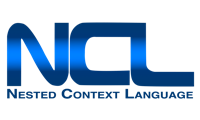Nested Context Language
Designed at TeleMídia Lab - PUC-Rio, NCL - Nested Context Language - is a declarative language for hypermedia-document authoring, which is based on NCM - Nested Context Model.
NCL was initially designed aiming at hypermedia document specification for the Web. The language flexibility, its reuse facility, multi-device support, application content and presentation adaptability, and mainly, its intrinsic ability for easily defining spatiotemporal synchronization among media assets, including viewer interactions, make it an outstanding solution for all kinds of DTV systems. For particular cases, as for example when dynamic content generation is needed, NCL provides the Lua (imperative) scripting language [2] support.
Lua is the powerful, fast, lightweight, embeddable scripting language of NCL. Lua combines simple procedural syntax with powerful data description constructs based on associative arrays and extensible semantics. Lua is dynamically typed, runs by interpreting bytecode for a register-based virtual machine, and has automatic memory management with incremental garbage collection, making it ideal for configuration, scripting, and rapid prototyping.
